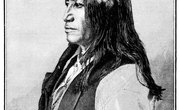What are Cherokee Symbols?
The Cherokee Nation, with 320,000 citizens and headquarters in Oklahoma, is the largest Native American tribe in the United States. Before being forcibly relocated in 1838, the Cherokee Indians inhabited land in several southeastern states. The Eastern Band of Cherokee has headquarters in western North Carolina and continues to inhabit the traditional Cherokee homeland. The Cherokee have traditionally sought to live in harmony with nature, and their symbolism reflects this predilection. While many European symbols tend to take over modern culture, many Cherokee symbols can be prominent in American culture, stemming from the American Indians, Cherokee culture and Cherokee people.
The Cherokee tribe used symbols for many things, like creeks, evil spirits, thunderbirds, Cherokee women, totems, and other artifacts from American history. Native American symbols are found in many places throughout the United States, and are prominent in artifacts and cave drawings. These symbols acted as a written language or writing system for the Native American cultures, like the Navajo, Cherokee, and many other Indian tribes in North America. These Indian symbols can be found all over the Americas, like in Georgia, southeast regions and in places where the eastern band of Cherokee Indians lived.
What are the Meanings of Cherokee Symbols?
Cherokee Sacred Numbers
The numbers four and seven recur in Cherokee stories, rituals and political arrangements. In the Cherokee cosmology, the Earth is suspended from the heavens by four cords, which correspond to the four cardinal directions, north, south, east and west. In addition, the Cherokee recognize three other directions, up, down and center, which is where you are. There are seven clans in the Cherokee nation, and the number seven also symbolizes a level of purity that few can attain. According to the Cherokee, two animals -- the owl and the cougar -- and five trees -- pine, cedar, spruce, laurel and holly -- have achieved this level.
Sacred Animals
In the Cherokee creation story, the animals inhabited an upper world called Galunlati when the Earth came into being, and they were told to keep watch over the creatures on Earth for seven days and nights. Only two animals were able to stay awake for the entire time, and these animals -- the owl and the cougar -- can accordingly see in the dark. The Cherokee particularly revere the owl because its eyes are on the front of its head, like those of humans. Because of the owl's connection to the spirit world, the Cherokee believe it brings medicine to the sick and that its appearance signifies an impending death. Healers with “owl medicine” bring comfort and visions of the future to those on their deathbed.
The Myth of the Pine Tree
One of the Cherokee legends related to anthropologist James Mooney, who lived among them for many years and collected their stories in his book, "Myths of the Cherokee," concerns the origin of the Pleiades, for which many cultures worldwide offer an explanation. In the Cherokee version, seven boys performed a spirit dance, and all but one rose into the sky to become the six main stars of that star cluster. The seventh was pulled down by his mother and swallowed by the earth. Every day the mother grieved at the spot where he fell, and eventually a pine tree grew from her tears. The Cherokee thus say that the pine has the same nature as the stars and shines with the same light.
The Cherokee Flag
At the center of the flag of the Cherokee Nation is a seven-pointed star, which represents the seven clans -- the Bird, Wild Potato, Blue, Wolf, Deer, Long Hair and Paint clans. Surrounding the star are garlands of leaves and acorns that represent the sacred fire that Cherokee spiritual leaders have maintained for hundreds of years. The words, “Seal of the Cherokee Nation,” surrounding the garlands are rendered in English and in the traditional Cherokee language. Seven stars, representing the seven clans, surround the central seal, and one black star, placed in the top right corner, represents the thousands who died on the Trail of Tears -- the forced relocation of the Cherokee from the southeastern states to Oklahoma in 1838, part of the "Indian Removal Act" passed by the U.S. Congress in 1830 and signed by President Andrew Jackson.
Related Articles
References
Resources
Writer Bio
Chris Deziel has a bachelor's degree in physics and a master's degree in humanities. Besides having an abiding interest in popular science, Deziel has been active in the building and home design trades since 1975. As a landscape builder, he helped establish two gardening companies.










